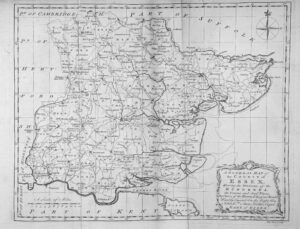
The aim of this short series of posts on the Essex homes (essentially northern Greater London, England) of Mabel’s kin – on her father’s side – is to give a quick look at the open spaces and sorts of landscapes that Mabel Bent (nee Hall-Dare) would have enjoyed as a young woman on the eastern shores of the Irish Sea, predisposing her to an adventurous, outdoor life – horses everywhere, rivers, forests, walks, new rail links, not to mention the travelling involved in getting up to Dublin from Co. Wexford and then across the sea to London (there were rented properties in ‘Town’ too of course), for stays in Essex before, for example, spending the long summers touring Europe with her siblings. Indeed, she was to meet her husband-to-be, Theodore Bent, in Norway on one such tour (although we still don’t know when, where, how, and why).
The Essex properties, lands, and churches featured include: (1) ‘Fitzwalters‘, (2) ‘East Hall’, (3) ‘Ilford Lodge‘, (4) ‘Cranbrook‘, (5) ‘Wyfields‘, ‘Theydon Bois’, and others, all with links in one way or another with Mabel Bent,
No. 2: East Hall – Wennington, near Rainham, Essex, UK.
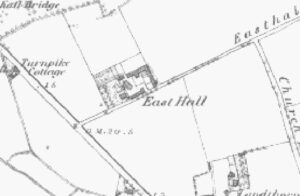
Although Mabel Bent never knew the eccentric and stylish Hall-Dare residence of Fitzwalters (see No. 1 in this series), the estate (c. 700 acres, c. 300 hectares) at Wennington, East Hall, near Rainham on the Thames, was extremely familiar to her and her immediate kin: indeed, in her obituary in the Paris Times of 5th July 1929 her birthplace is given (incorrectly) as Wennington.
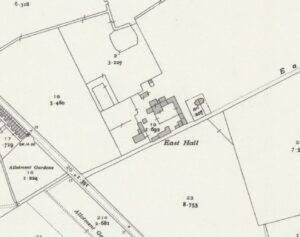
Wennington manor became linked to Mabel’s forebears (together with their Theydon Bois lands) via a series of late 18th-century marriages, and remained a Hall-Dare site in a direct line from Mabel’s grandfather and father, and then down through her brother and nephew – until it was disposed of in the early 20th century. (The place is not to be confused with the old East Hall of Dagenham Manor.) The manors of Wennington and Theydon Bois represented the bulk of the amalgamated families’ English holdings. Mabel’s brother Robert, although based in Ireland, took his stewardship of his Essex lands seriously and there are several references in his diary to visits there; his early death from typhoid in Rome in 1876 had a significant impact on the future development of the family’s land assets. The name East Hall remained on large-scale maps into the 1950s.
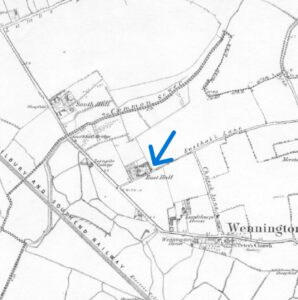
Unfortunately, a description of the East Hall mansion itself (possibly on an earlier site) has eluded us to date, but it is hoped one will surface – at least the outline on the Ordnance Survey maps of the period gives a good idea of its scale and scope, just to the west of the small village and its only surviving medieval building, the church of St Mary and St Peter, which would have welcomed Mabel on the Sundays she stayed in her father’s house – coming down from town on the new railway line.
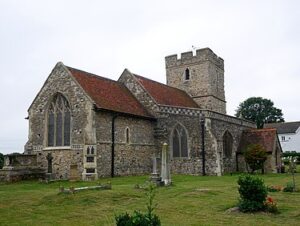
Those wishing to see how the manor came to be in the possession of Mabel’s father should see the detailed entry: ‘Wennington‘, in A History of the County of Essex: Volume 7, ed. W R Powell (London, 1978), pp. 180-190. (The Tithe Award Place-names of Wennington by Parcel Number reveal the extent of the families holdings (under Dare there are 268 references for 1839).)
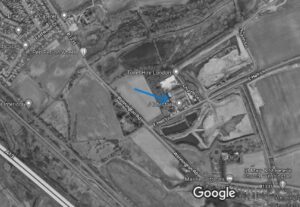
All that remains of the estate today are memories, the area has been devastated by modern quarry workings and is a sorry sight on Google Maps; perhaps the murder that occurred on the farm there in 1910 presaged its fate. Ironically, the modern-era desecration has revealed on the land a history going back to the Palaeolithic – archaeology to some degree was never far from Mabel and outlined her future by her husband’s side; she was born on the Boyne, not so very far from the Hill of Tara in the Celtic twilight.
Actually, there is one further souvenir – close to the turning to East Hall Lane you can find Halldare Cottage. A dwelling is marked there on the early maps, so presumably it had an association with East Hall and Mabel Bent’s family; it is a serendipitous survival.
See also ‘Wennington’, in The History and Antiquities of the County of Essex by Philip Morant (1768, London, pp.85-87); and the anonymous History of Wennington in 1882.
Coming next: No. 3: Ilford Lodge.
The back story
Of course Mabel was fortunate in that her family (on both sides) were landed (obviously) and comfortably off. Mabel’s paternal grandfather was the first of the Robert Westley Hall-Dares proper, an astute, baronial, figure who sat at the head of a coalition of wealthy and influential Essex families (Halls, Dares, Graftons, Mildmays, Kings, to name but a few), garnering in with him two major estates (Theydon Bois and Wennington) and various other demesnes, farms, and assorted dwellings, large and small. His wealth and assets were based on rents, farming, ventures, deals, and investments – including a sugar plantation in what is today British Guyana. This plantation, ‘Maria’s Pleasure‘, still retains its name, although it was disposed of after Mabel’s father, to whom the sugar estate had been left, received his compensation for the emancipation of around 300 slaves after Abolition (worth the equivalent of several millions of pounds now).
Robert Westley Hall-Dare the first (1789-1836), the Member of Parliament for South Essex from 1832 until his death, rubbed shoulders with the great and the good, not to mention London Society, but it was his son Robert Westley Hall-Dare the second (1817-1866) who actually married into (minor) aristocracy with his marriage to Frances, daughter of Gustavus Lambart of Beauparc, Co. Meath – Mabel (b. 1847) was one of their daughters.
Mabel was thus free to travel; her husband was the perfect fit; they were never slowed down by children. But if anyone should say to you, ‘Ah, but Mabel never worked’, then they don’t know what they are talking about: few women of her class would have sweated more, from Aksum to Great Zimbabwe.
 Leave a comment or contact us about this article
Leave a comment or contact us about this article
